Christ Church, Oxford
| Christ Church | ||||||||||||
|---|---|---|---|---|---|---|---|---|---|---|---|---|
 | ||||||||||||
|
Blazon: Sable, on a cross engrailed argent, a lion passant gules, between four leopards' faces azure, on a chief or, a rose gules barbed and seeded proper, between two Cornish choughs sable, beaked and membered gules. | ||||||||||||
|
| ||||||||||||
| University | Oxford | |||||||||||
| Coordinates | 51°45′01″N 1°15′21″W / 51.750199°N 1.255853°WCoordinates: 51°45′01″N 1°15′21″W / 51.750199°N 1.255853°W | |||||||||||
| Full name | The Dean, Chapter and Students of the Cathedral Church of Christ in Oxford of the Foundation of King Henry the Eighth | |||||||||||
| Established | 1546 | |||||||||||
| Named for | Jesus Christ | |||||||||||
| Sister college | Trinity College, Cambridge & Morse College | |||||||||||
| Dean | Martyn Percy | |||||||||||
| Undergraduates | 431[1] (2011/2012) | |||||||||||
| Postgraduates | 250 | |||||||||||
| Website |
www | |||||||||||
| Boat club | Boat Club | |||||||||||
| Map | ||||||||||||
 Location in Oxford city centre | ||||||||||||
Christ Church (Latin: Ædes Christi, the temple or house, ædēs, of Christ, and thus sometimes known as "The House") is a constituent college of the University of Oxford in England. The college is associated with Christ Church Cathedral, Oxford, which serves as the college chapel and whose dean is ex officio the college head.
It is the second wealthiest Oxford college by financial endowment (after St John's) with an endowment of £436m as of 2015.[2]
Christ Church has produced thirteen British prime ministers, more than any other Oxbridge college.
The college was the setting for parts of Evelyn Waugh's Brideshead Revisited, as well as a small part of Lewis Carroll's Alice's Adventures in Wonderland. More recently it has been used in the filming of the movies of J. K. Rowling's Harry Potter series and also the film adaptation of Philip Pullman's novel Northern Lights (the film bearing the title of the American edition of the book, The Golden Compass). Distinctive features of the college's architecture have been used as models by a number of other academic institutions, including the NUI Galway, which reproduces Tom Quad. The University of Chicago and Cornell University both have reproductions of Christ Church's dining hall (in the forms of Hutchinson Hall and the dining hall of Risley Residential College, respectively). ChristChurch Cathedral in New Zealand, after which the City of Christchurch is named, is itself named after Christ Church, Oxford. Stained glass windows in the cathedral and other buildings are by the Pre-Raphaelite William Morris group with designs by Edward Burne-Jones.[3][4]
Christ Church is also partly responsible for the creation of University College Reading, which later gained its own Royal Charter and became the University of Reading.
The first female undergraduates matriculated at Christ Church in 1980.[5]
History



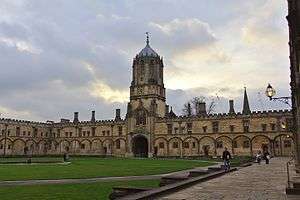
In 1525, at the height of his power, Thomas Wolsey, Lord Chancellor of England and Cardinal Archbishop of York, suppressed the Priory of St Frideswide in Oxford and founded Cardinal College on its lands, using funds from the dissolution of Wallingford Priory and other minor priories. He planned the establishment on a magnificent scale, but fell from grace in 1529, with the buildings only three-quarters complete, as they were to remain for 140 years.
In 1531 the college was itself suppressed, but it was refounded in 1532 as King Henry VIII's College by Henry VIII, to whom Wolsey's property had escheated. Then in 1546 the King, who had broken from the Church of Rome and acquired great wealth through the dissolution of the monasteries in England, refounded the college as Christ Church as part of the reorganisation of the Church of England, making the partially demolished priory church the cathedral of the recently created Diocese of Oxford.
Christ Church's sister college in the University of Cambridge is Trinity College, Cambridge, founded the same year by Henry VIII; these colleges were traditionally considered the most aristocratic of their universities. Since the time of Queen Elizabeth I the college has also been associated with Westminster School. The dean remains to this day an ex officio member of the school's governing body.[6][7]
Major additions have been made to the buildings through the centuries, and Wolsey's Great Quadrangle was crowned with the famous gate-tower designed by Sir Christopher Wren. To this day the bell in the tower, Great Tom, is rung 101 times at 9 pm at the former Oxford time (9:05 pm GMT/BST) every night, for the 100 original scholars of the college (plus one added in 1664). In former times this was done at midnight, signalling the close of all college gates throughout Oxford. Since it took 20 minutes to ring the 101, Christ Church gates, unlike those of other colleges, did not close until 12:20. When the ringing was moved back to 9:00 pm, Christ Church gates still remained open until 12.20, 20 minutes later than any other college. Although the clock itself now shows GMT/BST, Christ Church still follows Oxford time in the timings of services in the cathedral.
King Charles I made the Deanery his palace and held his Parliament in the Great Hall during the English Civil War. In the evening of 29 May 1645, during the second siege of Oxford, a "bullet of IX lb. weight" shot from the Parliamentarians warning-piece at Marston fell against the wall of the north side of the Hall.[8]
Several of Christ Church's deans achieved high academic distinction, notably Aldrich and Fell in the Restoration period, Jackson and Gaisford in the early 19th century and Liddell in the high Victorian era. During the Commonwealth, John Owen attained considerable eminence.
Organisation
Christ Church, formally titled "The Dean, Chapter and Students of the Cathedral Church of Christ in Oxford of the Foundation of King Henry the Eighth", is the only academic institution in the world which is also a cathedral, the seat (cathedra) of the Bishop of Oxford. The Visitor of Christ Church is the reigning British sovereign, and the Bishop of Oxford is unique among English bishops in not being the Visitor of his own cathedral.
The head of the college is the Dean of Christ Church, who is a clergyman appointed by the crown as dean of the cathedral church. There are a senior and a junior censor (formally titled the Censor Moralis Philosophiae and the Censor Naturalis Philosophiae) the former of whom is responsible for academic matters, the latter for undergraduate discipline. A Censor Theologiae is also appointed to act as the Dean's deputy.
The form "Christ Church College" is considered incorrect, in part because it ignores the cathedral, an integral part of the unique dual foundation.
Governing body
The governing body of Christ Church consists of the dean and chapter of the cathedral, together with the "Students of Christ Church", who are not junior members but rather the equivalent of the fellows of the other colleges. Until the later 19th century, the students differed from fellows in that they had no governing powers in their own college, these residing solely with the dean and chapter.
Buildings


Christ Church has a number of architecturally significant buildings. These include:
- Christ Church Library
- Peckwater Quadrangle
- The Great Quadrangle or Tom Quad including Tom Tower
- Blue Boar Quadrangle
- Canterbury Quadrangle
- The Old Library
- Christ Church Hall
- The Meadow Building
- The Lee Building
- Christ Church Cathedral
- Christ Church Picture Gallery
The college gardens, quadrangles, and meadow are Grade I listed on the Register of Historic Parks and Gardens.[9]
Cathedral choir

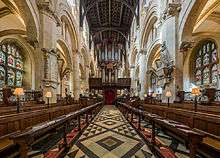
Christ Church is unique in that it has both a cathedral choir and a college choir. The cathedral choir comprises twelve men and sixteen boys. The men are made up of lay clerks and choral scholars, or academical clerks. The boys, whose ages range from eight to thirteen, are chosen for their musical ability and attend Christ Church Cathedral School. Aside from the director, there is also a sub-organist and two organ scholars. The college choir, however, is always a student run society, and sings Evensong once a week in term time. In vacations the services are sung by the Cathedral Singers of Christ Church (director John Padley) - a choir drawn from semi-professional singers in and around Oxford. The cathedral also hosts visiting choirs from time to time during vacations.
Throughout its history, the cathedral choir has attracted many distinguished composers and organists - from its first director, John Taverner, appointed by Cardinal Wolsey in 1526, to William Walton. The present director of music (known as the organist), is Stephen Darlington. In recent years, the choir have commissioned recorded works by contemporary composers such as John Tavener, William Mathias and Howard Goodall, also patron of Christ Church Music Society.
The choir, which broadcasts regularly, have many award-winning recordings to their credit and were the subject of a Channel 4 television documentary Howard Goodall's Great Dates. The documentary was nominated at the Montreux TV Festival in the arts programme category - and has since been seen internationally. The choir's collaboration with Goodall has also led to their singing his TV themes for Mr. Bean and Vicar of Dibley. They appeared in Howard Goodall's Big Bangs, broadcast in the United Kingdom on Channel 4 in March 2000. Treasures of Christ Church is the choir's most recent recording and debuted as the highest new entry in the UK Specialist Classical chart. The disc featured on BBC Radio 3’s In Tune on 26 September and on Radio 3’s Breakfast Show on 27 September.

Picture gallery
Christ Church holds one of the most important private collections of drawings in the UK, including works by Leonardo da Vinci, Raphael and Michelangelo. The collection is composed of approximately 300 paintings and 2,000 drawings, a rotated selection of which are available to the public for viewing in the purpose built Christ Church Picture Gallery. Many of the works were bequeathed by a former member of the college, General John Guise, enabling the creation of the first public art gallery in Britain.[10][11][12]
Coat of arms
College arms
The college arms are those of Cardinal Wolsey and were granted to him by the College of Arms on 4 August 1525.[13] They are blazoned: Sable, on a cross engrailed argent, between four leopards' faces azure a lion passant gules; on a chief or between two Cornish choughs proper a rose gules barbed vert and seeded or. The arms are depicted beneath a red cardinal's hat with fifteen tassels on either side, and sometimes in front of two crossed croziers.
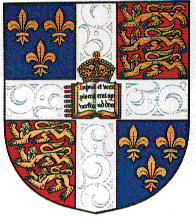
Cathedral arms
There are also arms in use by the cathedral, which were confirmed in a visitation of 1574. They are emblazoned: "Between quarterly, 1st & 4th, France modern (azure three fleurs-de-lys or), 2nd & 3rd, England (gules in pale three lions passant guardant or), on a cross argent an open Bible proper edged and bound with seven clasps or, inscribed with the words In principio erat Verbum, et Verbum erat apud Deum and imperially crowned or."
Graces
The college preprandial grace reads:
| Latin | English |
|---|---|
|
Nōs miserī hominēs et egēnī, prō cibīs quōs nōbis ad corporis subsidium benignē es largeītus, tibi, Deus omnipotēns, Pater cælestis, grātiās reverenter agimus; simul obsecrantēs, ut iīs sobriē, modestē atque grātē ūtāmur. Īnsuper petimus, ut cibum angelōrum, vērum panem cælestem, verbum Deī æternum, Dominum nostrum Iēsum Christum, nōbis impertiāris; utque illō mēns nostra pascātur et per carnem et sanguinem eius fovēāmur, alāmur, et corrōborēmur. Āmen. [14] |
"We unhappy and unworthy men do give thee most reverent thanks, Almighty God, our heavenly Father, for the victuals which thou hast bestowed on us for the sustenance of the body, at the same time beseeching thee that we may use them soberly, modestly and gratefully.
And above all we beseech thee to impart to us the food of angels, the true bread of heaven, the eternal Word of God, Jesus Christ our Lord, so that the mind of each of us may feed on him and that through his flesh and blood we may be sustained, nourished and strengthened. Amen." |
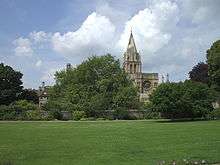
The first part of the grace is read by a scholar or exhibitioner of the House before formal Hall each evening, ending with the words Per Iēsum Christum Dominum nostrum ("Through Jesus Christ our Lord.") The remainder of the grace, replacing Per Iēsum Christum, etc., is usually only read on special occasions:
There is also a long postprandial grace intended for use after meals, but this is rarely used. When High Table rises (by which time the Hall is largely empty), the senior member on High Table simply says Benedictō benedīcātur ("Let the Blessed One be blessed", or "Let a blessing be given by the Blessed One"), instead of the college postprandial grace:
- (The Bible clerk reads from the Greek Testament.)
- Omnipotens et misericors Deus, qui donis Tuis nos exsatiasti, effice ut quicquid per nos fieri aut prætermitti velis, diligenter observemus, mandata Tua universa prompto atque fideli obsequio obeuntes, per Iesum Christum Dominum nostrum. Amen.
- Versicle: Domine, salvam fac Reginam.
- Response: Et exaudi nos, quando invocamus Te.
- Deus in cuius manu sunt corda regum; qui es humilium consolator, fidelium fortitudo, protector omnium in Te sperantium, da Reginæ nostræ Elizabethæ populoque Christiano ut Te Regem regum, et dominantium Dominum, agnoscant semper et venerentur, et post hanc vitam regni Tui æterni fiant participes ; per Iesum Christum Dominum nostrum. Amen.
- Deus, a quo derivatur omnis munificentia et bonitas, debitas Tibi gratias agimus, quod felicis memoriæ Regem Henricum eius nominis octavum, ad Ecclesiam hanc fundandam animaveris; et rogamus pro sancta Tua misericordia, ut cum nos hoc tanto beneficio adiuti, ad laudem Tui nominis profecerimus, una cum omnibus qui iam in Domino dormierunt, beatam resurrectionem, et æternæ felicitatis præmia consequamur, per Iesum Christum Dominum nostrum. Amen.
Student life
As well as rooms for accommodation, the buildings of Christ Church include the cathedral, one of the smallest in England, which also acts as the college chapel, a great hall, two libraries, two bars, and common rooms for dons, graduates and undergraduates. There are also gardens and a neighbouring sportsground and boat-house.
Accommodation is usually provided for all undergraduates, and for some graduates, although some accommodation is off-site. Accommodation is generally spacious with most rooms equipped with sinks and fridges. Many undergraduate rooms comprise 'sets' of bedrooms and living areas. Members are generally expected to dine in hall, where there are two sittings every evening, one informal and one formal (where gowns must be worn and Latin grace is read). The buttery next to the Hall serves drinks around dinner time. There is also a college bar (known as the Undercroft), as well as a Junior Common Room (JCR) and a Graduate Common Room (GCR).
There is a college lending library which supplements the university libraries (many of which are non-lending). Law students have the additional facility of the college law library, which has received large financial supplements from Christ Church law graduates. Most undergraduate tutorials are carried out in the college, though for some specialist subjects undergraduates may be sent to tutors in other colleges.
Croquet is played in the Masters' Garden in the summer. The sports ground is mainly used for cricket, tennis, rugby and football. Rowing and punting is carried out by the boat-house across Christ Church Meadow - the college is traditionally strong at rowing, having been Head of the River more times than any other. The college also owns its own punts which may be borrowed by students or dons.
The college beagle pack (Christ Church and Farley Hill Beagles), which was formerly one of several undergraduate packs in Oxford, is no longer formally connected with the college or the university, but continues to be staffed and followed by some Oxford undergraduates.
Christ Church references
"Midnight has come and the great Christ Church bell
And many a lesser bell sound through the room;
And it is All Souls' Night..." — W B Yeats, All Souls' Night, Oxford (1920)
"The wind had dropped. There was even a glimpse of the moon riding behind the clouds. And now, a solemn and plangent token of Oxford's perpetuity, the first stroke of Great Tom sounded." — Max Beerbohm, Chapter 21, Zuleika Dobson (1922)
"I must say my thoughts wandered, but I kept turning the pages and watching the light fade, which in Peckwater, my dear, is quite an experience – as darkness falls the stone seems positively to decay under one's eyes. I was reminded of some of those leprous façades in the vieux port at Marseille, until suddenly I was disturbed by such a bawling and caterwauling as you never heard, and there, down in the little piazza, I saw a mob of about twenty terrible young men, and do you know what they were chanting We want Blanche. We want Blanche! in a kind of litany." — Evelyn Waugh, Brideshead Revisited (1945)
"Those twins / Of learning that he [Wolsey] raised in you,
Ipswich and Oxford! one of which fell with him,
Unwilling to outlive the good that did it;
The other, though unfinish'd, yet so famous,
So excellent in art, and still so rising,
That Christendom shall ever speak his virtue." — William Shakespeare, Henry VIII
"By way of light entertainment, I should tell the Committee that it is well known that a match between an archer and a golfer can be fairly close. I spent many a happy evening in the centre of Peckwater Quadrangle at Christ Church, with a bow and arrow, trying to put an arrow over the Kilcannon building into the Mercury Pond in Tom Quad. On occasion, the golfer would win and, on occasion, I would win. Unfortunately, that had to stop when I put an arrow through the bowler hat of the head porter. Luckily, he was unhurt and bore me no ill will. From that time on he always sent me a Christmas card which was signed 'To Robin Hood from the Ancient Briton'" — Lord Crawshaw, House of Lords Hansard, Tuesday 8 July 1997
"There is one oddity; Rudge. Determined to try for Oxford, Christ Church of all places! Might get into Loughborough, in a bad year." - Alan Bennett, The History Boys
People associated with the college
Deans
Cardinal College
- 1525: John Hygdon
King Henry VIII's College
- 1532: John Hygdon
- 1533: John Oliver
Christ Church
Alumni
Notable former students of the college have included politicians, scientists, philosophers, entertainers and academics. Thirteen British Prime Ministers to have studied at the college including, Anthony Eden (Prime Minister 1955—1957), William Ewart Gladstone (1828–1831), Sir Robert Peel (1841–1846) and Archibald Primrose (1894–1895). Other former students include Charles Abbot (Speaker of the House of Commons 1802–1817), Frederick Curzon (Conservative Party statesman 1951–), Nicholas Lyell (Attorney General 1992–1997), Nigel Lawson (Chancellor of the Exchequer 1983–1989), Quintin Hogg (Lord Chancellor 1979–1987) and William Murray (Lord Chief Justice 1756—1788 and Chancellor of the Exchequer 1757). From outside the UK, politicians from Canada (Ted Jolliffe), Pakistan (Zulfikar Ali Bhutto) and the United States (Charles Cotesworth Pinckney) have attended the college.
Prominent philosophers including John Locke, John Rawls, A. J. Ayer, Gilbert Ryle, Michael Dummett, John Searle and Daniel Dennett studied at Christ Church.
There are numerous former students in the fields of academia and theology, including George Kitchin (the first Chancellor of the University of Durham 1908—1912 and Dean of Durham Cathedral 1894–1912), John Charles Ryle (first Bishop of Liverpool 1880–1900), John Wesley (leader of the Methodist movement), Rowan Williams (Archbishop of Canterbury 2002–2012), Richard William Jelf (Principal of King's College London 1843–1868), Ronald Montagu Burrows (Principal of King's College London 1913–1920) and William Stubbs (Bishop of Oxford 1889—1901 and historian).
In the sciences, polymath and natural philosopher Robert Hooke, developmental biologist John B. Gurdon (co-winner of the 2012 Nobel Prize in Physiology or Medicine), physician Sir Archibald Edward Garrod, the Father of Modern Medicine Sir William Osler, biochemist Kenneth Callow, radio astronomer Sir Martin Ryle, psychologist Edward de Bono and epidemiologist Sir Richard Doll are all associated with the college. Albert Einstein was a visiting scholar.
In other fields, Cameron and Tyler Winklevoss, twins associated with the founding of Facebook, King Edward VII (1841–1910), King of the United Kingdom and Emperor of India, rowing gold medallist Jonny Searle, entrepreneur and founder of Pennsylvania William Penn, broadcaster David Dimbleby, MP Louise Mensch, BBC composer Howard Goodall, the writer Lewis Carroll, are other notable students to have previously studied at Christ Church.
Gallery
 Christ Church Rooms
Christ Church Rooms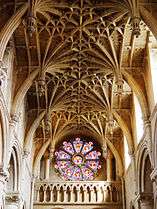 Christ Church Cathedral Ceiling
Christ Church Cathedral Ceiling Christ Church Cathedral altar
Christ Church Cathedral altar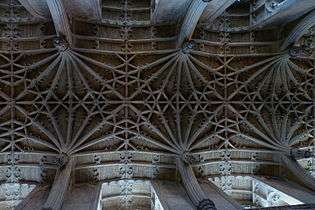 Cathedral ceiling
Cathedral ceiling- Christ Church Cathedral
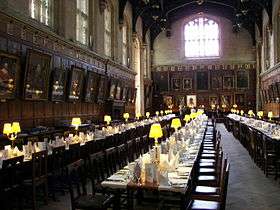 Christ Church Oxford Hall
Christ Church Oxford Hall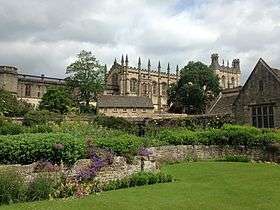 Garden Perspective.
Garden Perspective.
References
- ↑ "Undergraduate numbers by college 2011-12". University of Oxford. Archived from the original on 2 December 2012.
- ↑ Page 16, accessed 2 March 2016.
- ↑ Edward Burne-Jones Southgate Green Association "His work included both stained-glass windows for Christ Church in Oxford and the stained glass windows for Christ Church on Southgate Green."
- ↑ PreRaphaelite Painting and Design Archived 14 October 2008 at the Wayback Machine. University of Texas
- ↑ http://www.chch.ox.ac.uk/sites/default/files/Visitor_Information-gb.pdf
- ↑ "The Governing Body - Westminster School". Westminster School. Retrieved 6 August 2017.
- ↑ "Westminster School Intranet". Intranet.westminster.org.uk. Archived from the original on 13 July 2012. Retrieved 12 November 2011.
- ↑ Varley, Frederick John (1932). The Siege of Oxford: An Account of Oxford during the Civil War, 1642–1646. Oxford University Press. p. 128.
- ↑ Historic England, "Christ Church (1000441)", National Heritage List for England, retrieved 9 February 2016
- ↑ Christ Church Picture Gallery, Christ Church, Oxford; 22 January 2013. Retrieved 27 April 2013. Archived here.
- ↑ "Christ Church Matters, Issue 35" (PDF). pp. 12–15. Retrieved 25 August 2015.
- ↑ "Old Masters in an Oxford museum". Retrieved 25 August 2015.
- ↑ Curthoys, Judith (2012). The Cardinal's College: Christ Church, Chapter and Verse. Profile Press. pp. 4–5. ISBN 978 1 84668 617 7.
- ↑ Adams, Reginald (1992). The college graces of Oxford and Cambridge. Perpetua Press. pp. 62–64. ISBN 1-870882-06-7.
External links
| Wikimedia Commons has media related to Christ Church, Oxford. |
- Christ Church official website
- Oxford Cathedral
- Christ Church Junior Common Room website
- Christ Church Graduate Common Room website
- Christ Church Boat Club
- Official Virtual Tour of Christ Church
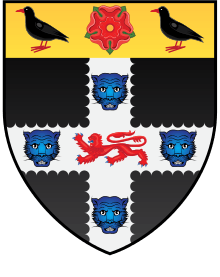









.svg.png)